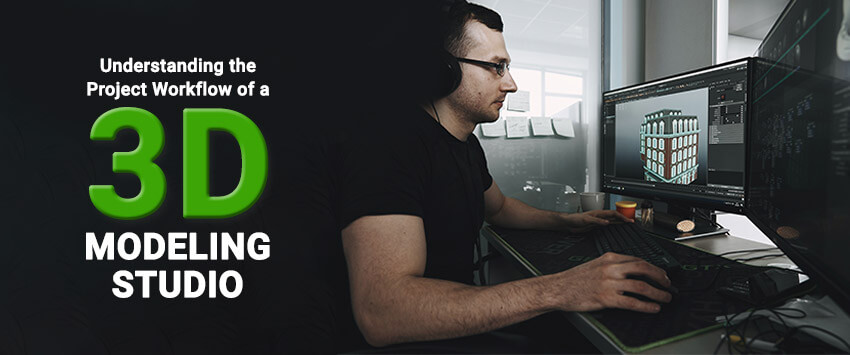3D Modeling Project Process Workflow : Step-by-Step Guide

3D modeling has become an investment for most businesses today. It is a process that needs time, effort, and resources to deliver clients the best results. As a result, many businesses outsource their 3d modeling requirements for an effective solution.
The modeling studio has an in-house team that is proficient in using 3D technology. So, outsourcing to these types of studios is convenient and profitable.
3D Modeling Project Workflow: A 6-Step Process
Every company has its 3D modeling process steps organized, which works well for them. 3D design companies are no exception. Understanding workflow helps in good communication and cooperation between the client and company. It helps avoid unwanted delays due to any misunderstanding. No one wants to confront such an issue.
This article is all about how the workflow in a 3D design studio. It is a working guide that we use at the 3D modeling studio for good client communication.
Step 1: 3D Design Requirement Submission
The client signs up with our modeling studio through the website and submits the order. The client gives all the required files during the sign-up process. We provide a catalogue design that helps the customers to make their choices if they are unsure of the model designs.
Useful Article : Tips to Get the Perfect 3D Modeling Image References
Step 2: Set Designing Goals
After starting the project, we contact the customer and assign them a project manager. The manager provides the customer with all project updates. Here, we set the deadlines for the project.
It is more of a project definition phase whereby we do,
Define scope
We define the project requirements, expected deliverables, budget, and delivery date. There are meetings scheduled with the client to finalize these things.Define timeframe
We produce and share a work schedule of the project with the customer.Define plan
Our studio provides a project plan and other formal plan documents to the customer.Ask questions
Also, the project manager interviews the customer and asks them a few questions such as:- What is the future use of 3D visualization models or apps?
- Is any modification necessary?
- What is the expected polygon count?
These types of questions help deliver results in a short turnaround time without reworks.
-
Step 3: Modeling
Now, after the discussions, the actual design process starts. The project manager gives the project to the design team that starts working on the project.
First, the team sits down and brainstorms design concepts and then sketch visuals. They develop 3D models . The studio sends the mock-up for client-approval.
Useful Article : Stages of 3D Model Creation From Basic to the Finished Product
-
Step 4: Texturing
The objects generated from the 3D models look grey by default. They need coloring and surface attributes corrections that meet real-world designs. A 3D wooden table should match the color and textures of a real-world model and the professional texturing experts do it. The objective is to make it look realistic when rendered.
-
Step 5: Corrections
3D modeling is a process that requires many real-time items for their project. When modelers don’t have the objects, they have to leash out their creativity to add the fine details. It is a cumbersome task that needs hard labor.
But it is a crucial stage of the 3D modeling that ensures the best project results. Hence, they stick to the following steps to have flawless working models.
Reviewing models
Designers test the 3D models for errors or bugs that happen during the motion or renderings.Finding the occurrence of interference
When two entities overlap in the design space, an interference check gets executed. It prevents conflicts in the complete 3D model.Validation and quality checks
Here, the model undergoes a sequence of tests. It ensures that the project lives the design, client, and business requirements.The feedback from the team and client help track the progress and make corrections. It is a process that saves the time and effort of the team and ultimately erases the tiring reworks.
Step 6: Project Completion and Delivery
Upon corrections, the modeling studio performs a specific set of actions mentioned below:
Fixing clash issues
The workings of the 3D project clash and interfere with each other at some point. The team fixes the conflict and cleans them before sending them to the final stage of delivery.Finalization
Whenever there is a bug or error in the prototypes of the 3D models, they get fixed at this stage. They also receive quality enhancement touches for the final delivery.File conversions
The final deliverables get converted into file formats such as OBJ, FBX, and STL. It gets done according to the industry-specific needs of the client.
Now, the company delivers the project to the client. The studio also offers visualization and product feature animations to customers. It is an area where 3D modelers excel.
Useful Link :14 Questions to Ask Before Hiring a 3D Design Firm
Which Industries Benefit From Outsourcing 3D Modeling Services?
Today, every industry has started realizing the potential of visualization with 3D modeling. We have provided a list of industries that use this modeling technique to witness growth.
Aeronautics and Aerospace
Use case: Prototyping and Visualization
-
Marketing and Advertising
Use case: Virtual Rendering
-
Automotive
Use case: Car Design
Retailers/Ecommerce
Use case: Retail Goods
-
Interior Design
Use case: Color, Texture
-
Gaming
Use case: Video games
-
Architects
Use case: Realistic visualizations of interiors and exteriors
Outsourcing 3D Modeling Services Checklist for Buyers
Are you planning to outsource 3D modeling services? The following checklist helps to find the best 3D modeling service providers in the market:
Portfolio check
The buyer can know about quality of the work samples and find out whether it aligns with their requirements.
Location and Working hours
Sometimes personal interaction might be necessary. So, check the time compatibility for better communication.
Experience
Here, the buyer can look at the number of years that the service provider has been operating. It is a good marker of the company’s expertise.
Staff interaction
The buyer can know about the employees with whom they will be working and their skill level.
Pricing
The buyer can ask the vendor to provide a signed estimate of all the costs.
Delivery time
The vendor should provide the customer with a clear schedule of the project plan. It should also include the date of delivery.
ISO Quality Certifications
The buyer can go with a service provider who has a 9001 ISO certification. A company with this certification provides consistent services that meet international standards.
Guarantees
Make sure that the service contract encompasses guarantees for delivery, quality, and service.
Data Security
Make sure that the company takes extra measures to protect confidential data.
We hope that this comprehensive guide will help you understand the work process of a 3D design company. Are you yet to pick the right company that suits your modeling requirements? Give our 3D modeling services a try today, which will enhance your business growth.
Contact Us

